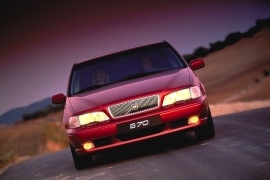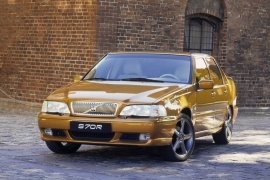VOLVO S70 Models/Series Timeline, Specifications & Photos
First production year: 1997
Engines: Gasoline, Diesel
When Volvo decided to get rid of its old-school, boxy design, it launched the first generation of the S40 in 1995 and then trimmed the 850 model to make the S70 in 1997.
The Swedish carmaker was known for its safe vehicles. To show that strength, it made its cars look like a pile of bricks one on top of another. But as time went by, the customers moved their attention toward more stylish vehicles with rounded shapes. Volvo had to adapt, and that's when the S40 came in, with some help from Mitsubishi, and the S70.
The S70's front fascia featured new headlights with rounded edges, and its inner sides tucked behind the grille, making them look slimmer. Its slightly curved side windows couldn't hide the original boxy origins, but at least it was sweetened. Again, a short trunk with rounded edges and corners was more like in the '90s trend in the back.
Inside, Volvo took more freedom of expression with a flowing line on top of the dashboard, instead of the older three-shaped roof-style instrument cluster from the 850. It lost a few air-vents, but it kept their squared look. There was enough legroom in the back for two adults, but three would stay cramped, especially in the AWD versions.
Under the hood, Volvo installed a choice of five-cylinder engines ranged between 126 hp and 241 hp. It was fitted as standard with 5-speed manual gearboxes, while a 4-speed automatic was available on selected engines.
VOLVO S70 2.0L 20V Turbo 4AT FWD (226 HP)
VOLVO S70 2.0L 20V Turbo 5MT FWD (226 HP)
VOLVO S70 2.0L 5MT FWD (126 HP)
VOLVO S70 2.0T 20V 4AT FWD (180 HP)
VOLVO S70 2.0T 20V 5MT FWD (180 HP)
VOLVO S70 2.3L T5 5MT FWD (241 HP)
VOLVO S70 2.4L 5MT FWD (140 HP)
VOLVO S70 2.4L 5MT FWD (170 HP)
VOLVO S70 2.4L T 5MT FWD (193 HP)
VOLVO S70 2.5L 5MT FWD (144 HP)
When Volvo introduced the R versions for the S70/V70 lineup, it aimed at the sporty Premium segment directly to Audi. BMW was too far, but at least it tried.
Volvo struggled to create new models or versions that could attract younger customers, and the first step was the 850. The S70 was its successor, and despite sharing the same platform, it was penned differently in a Swedish approach to the biodesign trend.
While its station wagon sibling, the V70, was a true factory sleeper for those who needed a family car, the S70 was much more oriented for those who didn't need a big trunk. Moreover, the sedan version was on par with Audi's A4 but with improved aerodynamic elements. At the front, the lower chin on the apron, the car sported a center air-intake flanked by two air-scoops where Volvo installed the fog lights. Those side vents were also used for cooling the front brakes. Another distinctive visual upgrade for the car was the five-spoke chromed wheels. At the back, the carmaker offered an option for a small wing on the trunk, but many customers didn't take that. They preferred a subtle look.
With its leather upholstery, the S70 R was aimed at those who had a taste for luxurious interiors. The high-bolstered seats at the front and the center stack tilted toward the driver were signs of a sport-oriented vehicle. At the back, there was enough room for two passengers, and the opera window behind the rear doors brought more light into the cabin.
Under the hood, Volvo installed an inline-five turbocharged powerplant that produced 234 hp and mated it with a five-speed manual. For those who preferred an automatic, a four-speed was available as an option.

